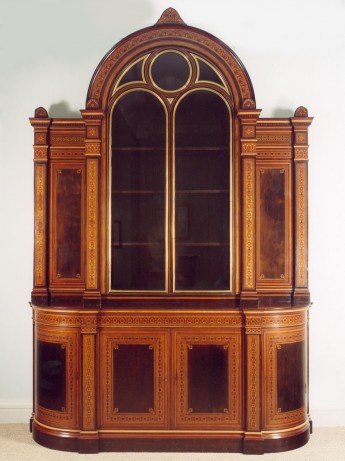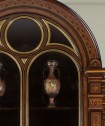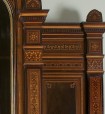Very Large Inlaid Cabinet Designed by Owen Jones for Alfred Morrison
English, 19th Century
Made by Jackson & Graham, of various woods, including ebony, purpleheart, holly and sycamore, the glazing of the central upper part framed in gilt-bronze. Circa 1865-70.
Height 11' 4½" (3,47m).
Width 7' 10½" (2,40m).
Depth 25¾" (65.5 cm).
Provenance :- Alfred Morrison (1821-1897), 16 Carlton House Terrace, London.
Illustrated :-
Caroline Dakers, 'Furniture and Interior Decoration for James and Alfred Morrison', Furniture History, Vol. XLVI, 2010, fig. 22, p. 207.
Kathryn Ferry, 'A Revolutionary in the Art of Colour', Country Life, 28th October 2009, p. 66.
Alfred Morrison, the great 19th Century collector and owner of the Fonthill estate, commissioned Owen Jones (1809-1874) to re-design the interiors of his London house, 16 Carlton House Terrace, in the 1860s. The house is part of the John Nash terrace overlooking St. James’ Park that was built for George IV, c. 1828. The interior of the house was treated in the same manner as this cabinet, using the same woods and design scheme. A contemporary description noted, ‘...the doors, wainscots, and many suites of furniture throughout the house are made of the finest marquetrie in inlaid natural woods’.(1) All of the work was undertaken by the firm of Jackson & Graham, who exhibited some of the pieces of furniture at the Vienna International Exhibition of 1873 and the London International Exhibition of 1874. The fine locks in the lower part of the present cabinet are recorded in the Chubb Archives as having been supplied on 15th September 1869, which is consistent with the date of this commission. Furthermore, the central arch of the cabinet is duplicated in the architecture of the interior of the house, in the shape of the door-cases and chimney-pieces. The ground floor Library chimney-piece surround has almost identical pilasters, topped by palmette acroteria.(2)
Owen Jones is a key figure in the history of design, Joint Architect of the Great Exhibition of 1851, and greatly involved in the formation of the South Kensington Museum, the precursor of the Victoria & Albert Museum. He is best known for his enormously influential compendium of Eastern and Western motifs, The Grammar of Ornament (1856), of which it has been said, ‘All the seminal designers and architects of the 19th Century, and many after, were greatly influenced by The Grammar of Ornament, which demonstrated to an international readership the potential of non-European, and in particular Islamic, decoration and of the systematic study of the principles of design, colour and ornament’.(3)
This last statement points to a particular significance of Owen Jones, his study of Islamic art and architecture and his influence in promoting it in the West. As well as the conventional Grand Tour, spent in Italy and Greece, he proceeded to Egypt and Turkey, and in 1834 to southern Spain, his first major work being a two volume survey of the Alhambra in Granada, Plans, Elevation Sections and Details of the Alhambra (1842-45). He has been described as ‘the first Westerner fully to appreciate Islamic architecture’,(4) and this present cabinet illustrates this very well, in both its overall form and in its detail. The central upper part is surely closely derived from Cairene architecture. The form of two upright oval-headed panels with an oculus above, all enclosed in an arched border, echoes the exterior and internal features of windows and lattice screens in the Mosque, Madrasa and Mausoleum of Sultan Qalawun, 683-84 H (1284-85 AD), the Mosque of Sultan Hassan, 757-64 H (1356-63 AD), or the Mosque and Madrasa of Sultan Al-Ghuri, 909 H (1504 AD). Owen Jones was certainly familiar with these buildings. He says in Chapter 8 of The Grammar of Ornament, ‘The mosques of Cairo are amongst the most beautiful buildings in the world. They are remarkable at the same time for the grandeur and simplicity of their general forms, and for the refinement and elegance which the decoration of these forms displays’, and he includes several images of interior detail from the Mosque of Sultan Qalawun (Plates XXXII and XXXIII).
Furthermore, the interior of the house for which this cabinet was made is very strongly inspired by Islamic design, in particular the remarkable geometric patterned ceilings.(5) It was an interest clearly shared by both designer and patron. Alfred Morrison collected in many areas, including Imperial Chinese porcelain,(6) but chief among them were Islamic and Orientalist art. He was, for example, the major foreign patron of the Spanish metal-worker, Placido Zuloaga (1834-1910), having no less than forty pieces by him at Carlton House Terrace, including a magnificent centre table now in the British Royal Collection.(7) A marquetry door panel from the Library of 16 Carlton House Terrace is now in the Minneapolis Institute of Art,(8) and in the museum’s description of this panel it is said,
‘Jones’s own adaptation of the Islamic style is best exemplified by the interiors he created for 16 Carlton House Terrace, the London townhouse of scholar and antiquarian AlfredMorrison. Jones and Morrison’s passion for Orientalism and craftsmanship, with the help of Morrison’s considerable fortune, resulted in a rich layering of ornament throughout the townhouse’s first two floors’.
Another of these marquetry panels, the marquetry of which is very similar to that of the present cabinet, is in the Victoria & Albert Museum,(9) and amongst the very few other known pieces of furniture designed by Owen Jones for Carlton House Terrace are a pair of armchairs, one in the Art Institute of Chicago, the other in the Carnegie Museum of Art, Pittsburgh.(10) This present cabinet is by far the largest piece of furniture known from this commission, and the largest piece known by Owen Jones. The height of the lower part is consistent with the height of the dado in the first floor rooms of 16 Carlton House Terrace, and it is tempting to identify it with the following piece of furniture described in the same contemporary account referred to above: ‘One of the most curious features of the house - an enormous cabinet, filled with a service of Minton’s ware - occupies one wall of the room’.(11)
The firm of Jackson & Graham were a byword for exceptional quality of manufacture, and the details of the construction of this present cabinet exemplifies this, quite apart from the obvious remarkable quality of the inlaid marquetry. For example, the top arched section, seen from the side, is veneered and banded; the glazing is bevelled on each side of the glass; the lower doors are laminated, so that they do not split or warp; the interior and shelves of the upper part are veneered and banded, to match the exterior main fields; and the interior of the lower part, generally not visible, is also finely veneered and panelled.
_______________________
Footnotes
1) Mrs Haweis, Beautiful Houses, 1882, p. 54.
2) See The Offices of the Crown Estate, Carlton House Terrace, published by the Crown Estate, 1999, p. 4.
3) Simon Jervis, Design and Designers, 1984, pp. 259-260.
4) Kathryn Ferry, ‘A Revolution in Colour’, Apollo, September 2009.
5) See John Cornforth, ‘Arabian Nights in the Mall’, Country Life, May 18th 1989, figs. 1, 3, 6 and 7, pp. 246, 248, 249. Also Carol A. Hvrol Flores, Owen Jones, 2006, figs. 4.39 and 4.42-4.46, p. 192 and p. 194.
6) A Chinese vase previously owned by Morrison sold recently at auction in Hong Kong for a record price of HK$225m.
7) Royal Collection ref. RCIN 2526. See Caroline Dakers, ‘Furniture for James and Alfred Morrison’, Furniture History, Vol. XLVI, 2010, fig. 25, p. 210.
8) Museum no. 2002.16.
9) Museum no. W.43:1-1970.
10) Flores, op. cit., Pl. 4.9, p. 212. Previously owned by Harris Lindsay.
11) Mrs. Haweis, op. cit., p. 59.





